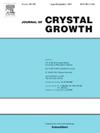High-pressure self-flux growth and characterization of Li-deficient Li0.95FeAs single crystals
IF 1.7
4区 材料科学
Q3 CRYSTALLOGRAPHY
引用次数: 0
Abstract
Single crystals of LiFeAs were successfully grown by a self-flux method using the cubic anvil high-pressure and high-temperature technique. The reaction took place in a closed boron nitride crucible at a pressure of 1 GPa and a temperature of 1050 °C. The grown crystals, retrieved from solidified lump, exhibit plate-like shapes with sizes up to 0.7 × 0.7 × 0.15 mm3. Single-crystal x-ray diffraction refinement confirmed the high structural perfection of the grown crystals [space group P4/nmm, No 129, Z = 2, a = 3.77370(10) Å, c = 6.3468(6) Å, and V = 90.384(9) Å3] with the presence of a small deficiency on the Li site. The refined chemical composition of the produced crystals is Li0.95FeAs. Temperature-dependent magnetization measurements revealed bulk superconductivity with a superconducting transition Tc = 16 K. A comparative analysis of LiFeAs, Li1-xFeAs, and Li1-yFe1+yAs systems reveal that superconductivity is less sensitive to the Li deficiency, although it may completely disappear in the presence of both Fe excess and Li deficiency.
缺锂 Li0.95FeAs 单晶的高压自流生长和表征
利用立方砧高压高温技术,通过自流式方法成功地生长出了锂铁砷单晶体。反应在封闭的氮化硼坩埚中进行,压力为 1 GPa,温度为 1050 ℃。从凝固的块状物中取出的生长晶体呈板状,大小可达 0.7 × 0.7 × 0.15 mm3。单晶 X 射线衍射细化证实了生长出的晶体具有高度完美的结构[空间群 P4/nmm,No 129,Z = 2,a = 3.77370(10) Å,c = 6.3468(6) Å,V = 90.384(9) Å3],在锂位点上存在一个小的缺陷。所生成晶体的化学成分为 Li0.95FeAs。对 LiFeAs、Li1-xFeAs 和 Li1-yFe1+yAs 系统的比较分析表明,超导性对锂的缺失不太敏感,但在铁过剩和锂缺失的情况下,超导性可能会完全消失。
本文章由计算机程序翻译,如有差异,请以英文原文为准。
求助全文
约1分钟内获得全文
求助全文
来源期刊

Journal of Crystal Growth
化学-晶体学
CiteScore
3.60
自引率
11.10%
发文量
373
审稿时长
65 days
期刊介绍:
The journal offers a common reference and publication source for workers engaged in research on the experimental and theoretical aspects of crystal growth and its applications, e.g. in devices. Experimental and theoretical contributions are published in the following fields: theory of nucleation and growth, molecular kinetics and transport phenomena, crystallization in viscous media such as polymers and glasses; crystal growth of metals, minerals, semiconductors, superconductors, magnetics, inorganic, organic and biological substances in bulk or as thin films; molecular beam epitaxy, chemical vapor deposition, growth of III-V and II-VI and other semiconductors; characterization of single crystals by physical and chemical methods; apparatus, instrumentation and techniques for crystal growth, and purification methods; multilayer heterostructures and their characterisation with an emphasis on crystal growth and epitaxial aspects of electronic materials. A special feature of the journal is the periodic inclusion of proceedings of symposia and conferences on relevant aspects of crystal growth.
 求助内容:
求助内容: 应助结果提醒方式:
应助结果提醒方式:


